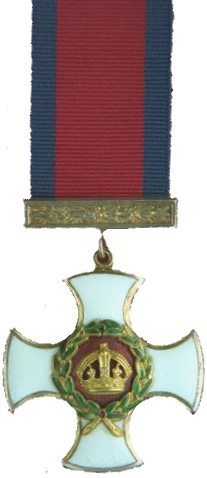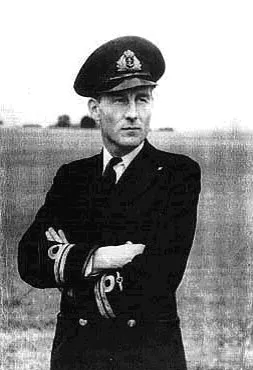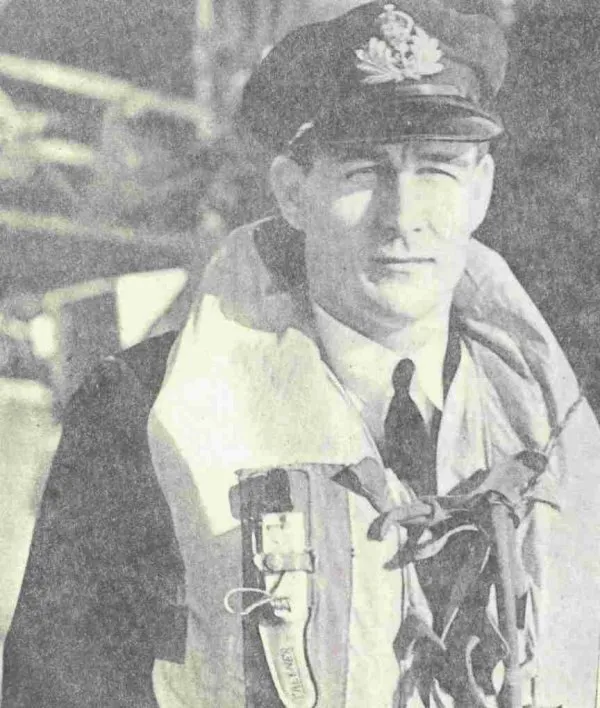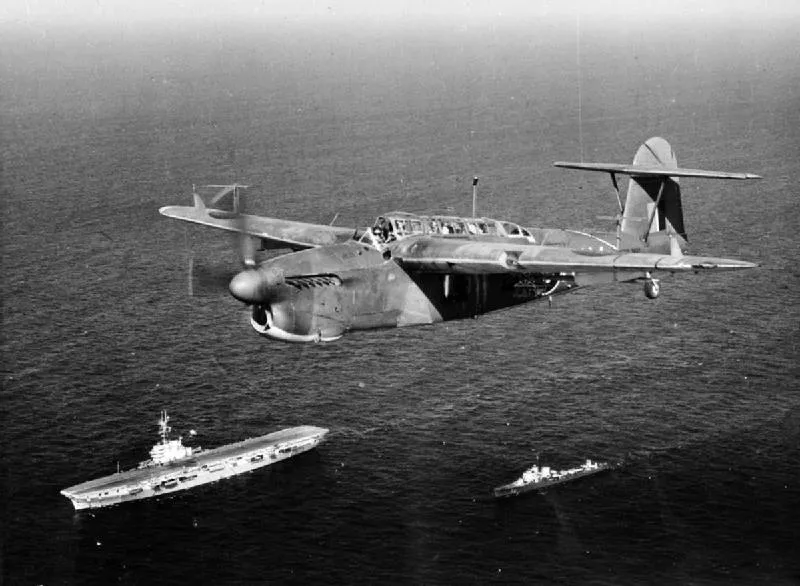
Citation for Distinguished Service Cross awarded as per London Gazette of 25 July 1944:
"For outstanding zeal, patience and cheerfulness, and for setting an example of wholehearted devotion to duty, without which the high tradition of the Royal Navy could not have been upheld".

Citation for Distinguished Service Order awarded as per London Gazette of 30 May 1944:
"For undaunted courage, skill and determination in carrying out the daring attack on the German Battleship TIRPITZ on 3 April 1944".

Citation for Mentioned in Dispatches awarded as per London Gazette of 25 July 1944:
"For bravery, leadership, skill and devotion to duty while operating from, or serving in H.M. Ships during successful strikes at enemy shipping off the coast of Norway".
The crew of 830 Squadron Barracuda aircraft LS 556 5K, flying from HMS Formidable, were lost at sea in poor weather conditions while an anti-submarine patrol
Pilot Wing Leader Lieutenant Commander Roy Sydney Baker-Falkner DSC DSO MiD (RN-FAA), Observer Lieutenant GN Micklem DSC MiD (RNVR-FAA) and Air Gunner Temporary Petty Officer AH Kimberley MiD (RN-FAA) were all missing, presumed Killed in Action
These aircrew have no known grave and all are commemorated on the Fleet Air Arm Memorial at Lee-on-the-Solent, Hampshire, UK
![]() Battle of Britain London Monument-Lt(FAA) RS Baker-Falkner
Battle of Britain London Monument-Lt(FAA) RS Baker-Falkner
![]() Royal Navy Fleet Air Arm Flying Personnel 1939-1947
Royal Navy Fleet Air Arm Flying Personnel 1939-1947

Roy Sydney Baker-Falkner
Roy Sydney Baker-Falkner was born on 3rd June 1916 in Nottingham, England; his father was stationed in Britain with the 79th Battalion Canadian Expeditionary Force. The family returned to Canada in early 1918, eventually moving to Saanich on Vancouver Island, British Columbia, to be close to their cousin, a magistrate at Steveston near Vancouver.
In mid 1929, Baker-Falkner applied to join the Navy at Esquimalt naval base, British Columbia. As the Royal Naval College of Canada at Esquimalt had closed eight years previously, he was transferred to the United Kingdom on a Canadian Commonwealth Scholarship. Along with other RCN cadets, he enrolled for officer training at the Royal Naval College at Dartmouth. In 1934, as a midshipman, he was appointed to HMS Kent, flagship of the China Fleet.
In 1937 he transferred to the Royal Navy Fleet Air Arm as a pilot, completing his pilot training with the Royal Air Force. Baker-Falkner earned his pilot's wings in 1938 with the rank of Sub-Lieutenant RN/Flight Lieutenant RAF, and specialized in torpedo reconnaissance.
He was appointed to an operational carrier-based squadron in HMS Glorious in the Mediterranean. On the outbreak of war in September 1939, his Fairey Swordfish squadron was actively involved in the search for the German warship Graf Spee in the Indian Ocean.
Baker-Falkner returned to England in Spring 1940 and was seconded to a shore-based squadron where he supported the evacuation of troops from Dunkirk and later participated in the Battle of Britain. He was one of the few Canadian naval officers to participate in this battle. He then was seconded to RAF Coastal Command, flying the venerable Swordfish biplane in mining missions against the German coastline.
For his actions he was awarded the Distinguished Service Cross. After 15 months of operational duties, in August 1941 Baker-Falkner was attached as a pilot instructor to the Fleet Air Arm air station at RNAS Condor in Arbroath, Scotland, at which time he took part in the Royal Navy information film "Find, Fix and Strike".
He was appointed as commanding officer of 767 squadron in August 1942. Subsequently in October 1942 he was appointed to the Royal Navy aircraft testing squadron at RAF Boscombe Down as a test pilot, and proved instrumental in testing naval aircraft prior to their operational use by the Royal Navy. Chief amongst these was the dive-bomber, the Fairey Barracuda. Based on his unique skills with the Barracuda, he was given command of 827 squadron in August 1943, the first Royal Navy unit equipped with this advanced dive-bomber.
Baker-Falkner was soon appointed Wing Leader of 8 Torpedo Bombing Reconnaissance Naval Air Wing, which consisted mainly of young Australian, British, Canadian and New Zealand Volunteer Reserve aircrews. The Wing joined the carrier HMS Furious in the Orkney Islands off Scotland in February 1944.
Baker-Falkner led the Wing on an air strike against enemy shipping in north Norway, supported by the Home Fleet and three Canadian Tribal class destroyers, HMC Ships Iroquois, Haida and Athabaskan.
On 30th March 1944, No. 8 Naval Air Wing embarked from Hatston in Scotland to the Fleet carriers HMS Furious and HMS Victorious to lead Operation Tungsten, an air attack on the giant German battleship Tirpitz, anchored in a Norwegian fjord.
Coincidentally, the strike force was escorted in part by HMC Ships Algonquin and Sioux. This was Algonquin's first operation against the enemy. Baker-Falkner led an audacious low-level dive-bombing attack against Tirpitz on 3rd April 1944.
The air strike of 121 aircraft, including 40 Barracuda and 40 Wildcats, was a success; Baker-Falkner's Wing shared 14 dive-bombing hits, crippling Tirpitz. This decisive action prevented Tirpitz from posing a major threat in the forthcoming invasion of Normandy by the allies in June 1944. The aircrews returned to Scotland in the unaccustomed full glare of the international media.
In July the Wing was ordered to undertake further operations against Tirpitz. The squadrons boarded the Fleet Carriers Formidable, Furious and Indefatigable and conducted a strike on 17th July, 1944.
Baker-Falkner led the strike of some 92 aircraft, but German submarines spotted the advancing armada and surprise was lost. With Tirpitz surrounded by a smoke screen, the aircraft were unable to deliver accurate attacks, and so the mission met with limited success.
On 18th July 1944, with the Fleet threatened by U-Boat wolf packs, Lt. Cdr. Baker-Falkner was launched on the first anti-submarine patrol. Flying a Barracuda II aircraft with the serial LS556 and the squadron code 5K, he was assisted by his Observer, Lt. GN Micklem, and his tactical Air Gunner (TAG), PO AH Kimberley.
A Corsair of 1841 squadron flown by the senior pilot, Sub Lt. HS Mattholie, escorted his Barracuda.
Tragically, the weather worsened and Baker-Falkner's Barracuda and the Corsair failed to find the Fleet and became separated. Baker-Falkner and his crew were lost at sea. Sub Lt Mattholie crash-landed in Norway and was subsequently taken prisoner. Sub Lt. Mattholie's successor as senior pilot in 1841 squadron was Lt. Robert Hampton Gray RCNVR, who was later to posthumously earn the Victoria Cross in the Pacific.
Roy Baker-Falkner was awarded the Distinguished Service Order (DSO) on 25th July 1944 and mentioned in dispatches for his 'bravery, leadership, skill and devotion to duty while operating from, or serving in HM Ships during successful strikes at enemy shipping off the coast of Norway'.
He is commemorated on the Fleet Air Arm Memorial at Lee-on-Solent. Graham Falkner Drucker (nephew of Roy Baker-Falkner)




